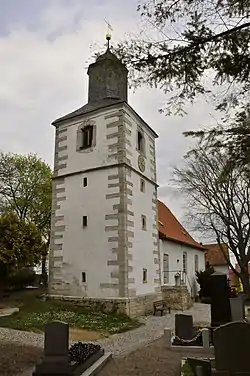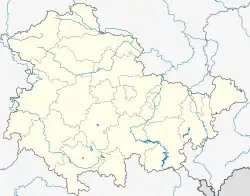Eckardtsleben | |
|---|---|
 St Vitus' Church | |
Location of Eckardtsleben within Bad Langensalza  | |
 Eckardtsleben  Eckardtsleben | |
| Coordinates: 51°4′13″N 10°40′51″E / 51.07028°N 10.68083°E | |
| Country | Germany |
| State | Thuringia |
| District | Unstrut-Hainich-Kreis |
| Town | Bad Langensalza |
| First mentioned | 932[1] |
| Government | |
| • Ortsteilbürgermeister | Dirk Schmidt[1] |
| Area | |
| • Total | 4.66 km2 (1.80 sq mi) |
| Elevation | 243 m (797 ft) |
| Population (2020-12-31)[2] | |
| • Total | 195 |
| • Density | 42/km2 (110/sq mi) |
| Time zone | UTC+01:00 (CET) |
| • Summer (DST) | UTC+02:00 (CEST) |
| Postal codes | 99947 |
| Dialling codes | 03603 |
| Website | badlangensalza.de |
Eckardtsleben (pronounced [ˈɛkaʁtsleːbn̩]) is a village and part of the town of Bad Langensalza in Thuringia, central Germany, with about 200 inhabitants.[2]
Geography
Eckardtsleben is located 4.85 kilometres (3.01 mi) (linear distance) south of Bad Langensalza (Market Church) and on the Landesstraße (state road) 2125 (Bad Langensalza–Aschara). The village lies on both sides of a stream valley sloping down to the north-east. The Schwarzer Bach ("Black Brook"), which rises near Wiegleben, flows through the village from west to east and leaves the village as the Reifenheimer Graben ("Reifenheim Ditch") to flow into the Tonna a little below the Gräfentonna village mill. Since its source, the stream has travelled 8.86 kilometres (5.51 mi) and lost 140 metres (460 ft) in height. The intensively used flat-wavy terrain belongs to the arable farming area of the Thuringian Basin. The soils are fertile and mostly influenced by groundwater. Small erosion gullies, mostly vegetated, break up the landscape.
The Eckardtsleben stop on the Gotha–Leinefelde railway line is located to the south of the village.
History
Eckardtsleben was first mentioned in a document on 1 June 932.[3] The village belonged to the sub-county of the Tonna dominion, which from 1677 belonged to the Duchy of Saxon-Gotha-Altenburg as the "Amt Tonna".
The village has a rural character without multi-storey high-rise and new buildings and is characterised by agriculture.[1]
Sights
St Vitus' Church was built in 1404. Today, it is a Lutheran daughter church. The organ with one manual, one pedal and 8 stops was built by Gustav Koch.[4]
References
- 1 2 3 "Eckardtsleben" (in German). Stadt Bad Langensalza. 19 February 2020. Retrieved 30 May 2022.
- 1 2 "Wirtschaft – Standortinformationen" [Economy – location information] (in German). Stadt Bad Langensalza. 19 February 2020. Retrieved 30 May 2022.
- ↑ Kahl, Wolfgang (2010). Ersterwähnung Thüringer Städte und Dörfer – Ein Handbuch (in German) (5 ed.). Bad Langensalza: Rockstuhl Verlag. p. 63. ISBN 978-3-86777-202-0.
- ↑ "Eckardtsleben, Deutschland (Thüringen) - Dorfkirche Sankt Vitus". orgbase.nl. Retrieved 30 May 2022.
External links
![]() Media related to Eckardtsleben at Wikimedia Commons
Media related to Eckardtsleben at Wikimedia Commons